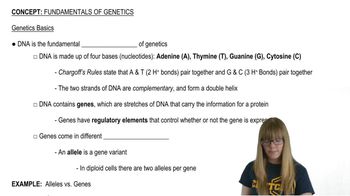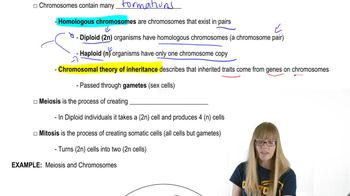Table of contents
- 1. Introduction to Genetics51m
- 2. Mendel's Laws of Inheritance3h 37m
- 3. Extensions to Mendelian Inheritance2h 41m
- 4. Genetic Mapping and Linkage2h 28m
- 5. Genetics of Bacteria and Viruses1h 21m
- 6. Chromosomal Variation1h 48m
- 7. DNA and Chromosome Structure56m
- 8. DNA Replication1h 10m
- 9. Mitosis and Meiosis1h 34m
- 10. Transcription1h 0m
- 11. Translation58m
- 12. Gene Regulation in Prokaryotes1h 19m
- 13. Gene Regulation in Eukaryotes44m
- 14. Genetic Control of Development44m
- 15. Genomes and Genomics1h 50m
- 16. Transposable Elements47m
- 17. Mutation, Repair, and Recombination1h 6m
- 18. Molecular Genetic Tools19m
- 19. Cancer Genetics29m
- 20. Quantitative Genetics1h 26m
- 21. Population Genetics50m
- 22. Evolutionary Genetics29m
1. Introduction to Genetics
Fundamentals of Genetics
Problem 10f
Textbook Question
Define each of the following terms:
phenotype
 Verified step by step guidance
Verified step by step guidance1
Phenotype refers to the observable characteristics or traits of an organism, such as its morphology, development, biochemical or physiological properties, and behavior.
These traits result from the expression of an organism's genes as well as the influence of environmental factors and the interactions between the two.
Phenotypes can include physical attributes like height, eye color, and leaf shape, as well as biochemical and physiological properties like blood type or enzyme activity.
The phenotype is distinct from the genotype, which is the set of genes that an organism carries.
While the genotype provides the potential for certain traits, the phenotype is the actual expression of those traits in the organism.
Recommended similar problem, with video answer:
 Verified Solution
Verified SolutionThis video solution was recommended by our tutors as helpful for the problem above
Video duration:
1mPlay a video:
Was this helpful?
Key Concepts
Here are the essential concepts you must grasp in order to answer the question correctly.
Phenotype
Phenotype refers to the observable physical and physiological traits of an organism, which result from the interaction of its genotype with the environment. This includes characteristics such as height, eye color, and behavior. While the genotype is the genetic makeup, the phenotype is the expression of those genes influenced by environmental factors.
Recommended video:
Guided course

Mutations and Phenotypes
Genotype
Genotype is the genetic constitution of an organism, representing the specific alleles inherited from its parents. It serves as the blueprint for the organism's traits, but it does not directly dictate the phenotype. Understanding the genotype is crucial for predicting potential phenotypic outcomes, as different genotypes can lead to similar phenotypes due to environmental influences.
Recommended video:
Guided course

Gamete Genotypes
Environmental Influence
Environmental influence encompasses all external factors that can affect the expression of an organism's phenotype. These factors include nutrition, climate, and exposure to toxins, among others. The interaction between genotype and environment is essential for understanding how traits are expressed, as the same genotype can produce different phenotypes under varying environmental conditions.
Recommended video:
Guided course

Maternal Effect

 8:55m
8:55mWatch next
Master Genetics Basics with a bite sized video explanation from Kylia Goodner
Start learning



